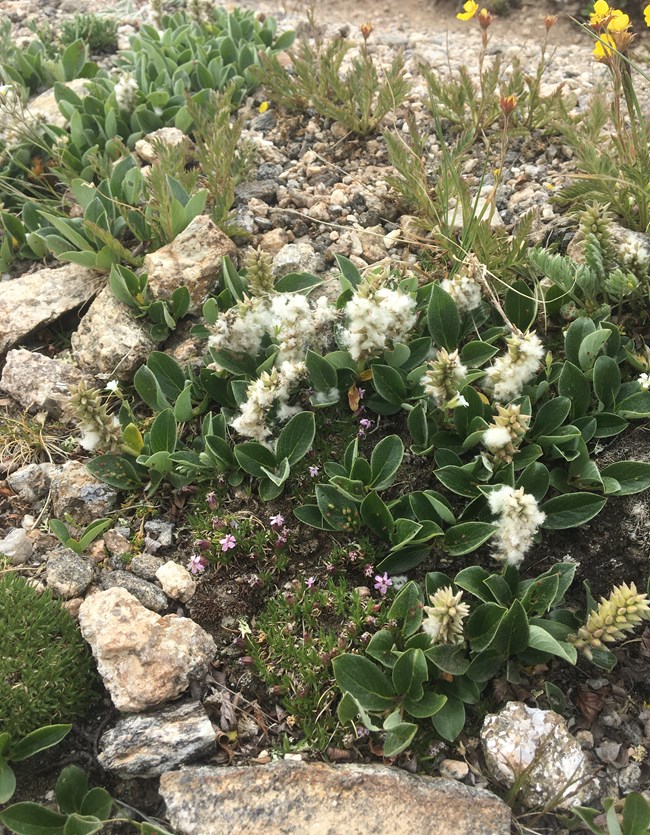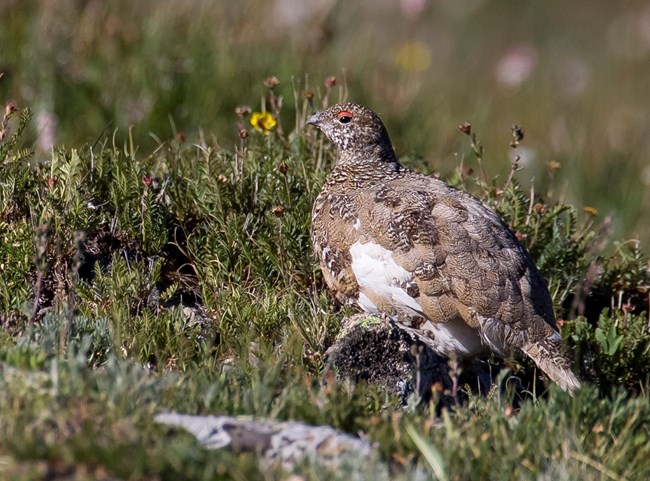Last updated: July 29, 2020
Article
Little Willows at Great Heights

NPS/C Turner
Spread across Rocky Mountain National Park’s alpine tundra is a carpet of life—at times quiet and discrete, at others loud and bursting with color. Amid this rugged landscape, with its craggy rock outcroppings and small but persistent snow fields, a few small, short, and determined species of willow (Salix spp.) make their home. These alpine willow plants persist against the intense summer sun, cold winter temperatures, and strong, harsh winds.
Often, the word ‘willow’ brings to mind a movie-like settings featuring a friendly, tall weeping willow tree—it’s long thin branches dangling to the ground, a tire swing hanging from its lower branches; or a young person, book in hand, enjoying its shade. But Rocky’s willows of the alpine, although related, are so very different. They are shrubby, growing short or staying low to the ground, with thick waxy leaves to keep in moisture. The smallest also have hairs along their short stems to break the raging winds. It’s a short season on the tundra; willows grow, flower, and seed within a few short months.
There are 17 confirmed species of willow found in the park. Four of these species are common within the park’s alpine tundra: Salix brachycarpa (barrenground willow), Salix reticulata (snow willow), Salix petrophila (alpine willow), and Salix planifolia (planeleaf willow). While the barrenground and planeleaf willows grow taller with a classic shrub look, the snow and alpine willows grow as a ground cover amid the grasses and wildflowers. Another species, Salix glauca (grayleaf willow), is likely present in the tundra and is known to hybirdize with S. brachycarpa.

NPS/A Schonlau

NPS/A Schonlau
Another interesting study conducted in the late 1970s, investigated diet selection in habitats frequented by elk during the summer months (Baker and Hobbs 1982). Using tame, trained elk, observers recorded the species of plants the animals grazed on, the number of bites they took of each species, and the parts of the plants on which the elk fed. Elk grazing in the alpine tundra were found to forage a variety of plants including sedges, rushes, tufted hairgrass, alpine avens, marshmarigold and willows. Barrenground and planeleaf willows accounted for approximately 11% of bites made by tundra grazing elk.
Questions about willows in the alpine continue to interest park managers. Willows have an important role to play in the alpine tundra. Understanding how changing conditions affect willow, and how changes in alpine willow cover and size influence the species that depend on them, will be valuable in addressing management concerns.
Baker, D.L. and N.T. Hobbs. 1982. Composition and Quality of Elk Summer Diets in Colorado. Journal of Wildlife Management 46(3): 694-703
Zeigenfuss, L. 2006. Alpine Plant Community Trends on Elk Summer Range of Rocky Mountain National Park, Colorado: an analysis of existing data. U.S. Geological Survey, Open-File Report 2006-1122, 21 p.
July 2020
